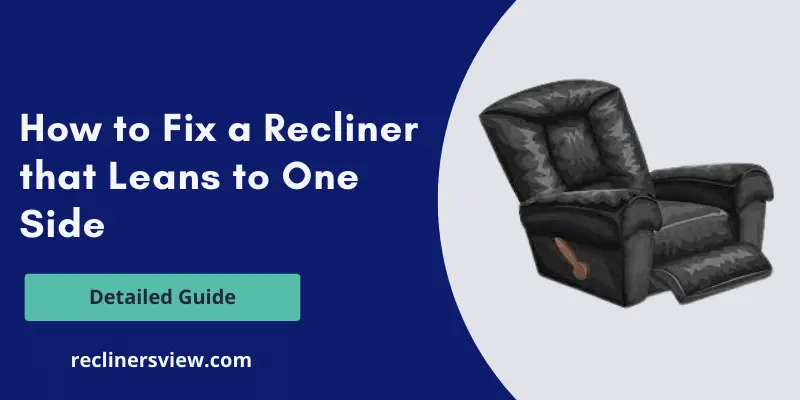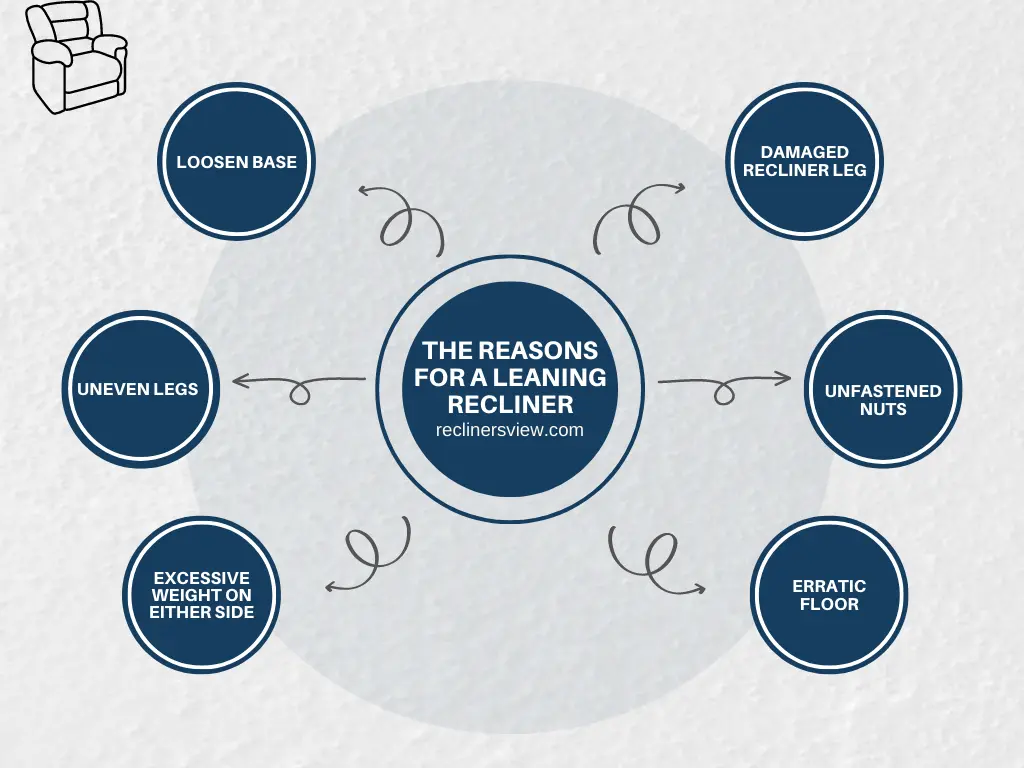Comfort comes first and this is why people nowadays are opting for more comfortable recliners rather than stylish, flair sofas. Recliners have transformed our idea of comfortable seating to become the pinnacle of relaxation, from headrests to heated massage pads.
Why, after all, would anyone settle for a sofa that doesn’t recline when they have the opportunity to sit back and unwind like never before?
However, when you bring a new product home, set it up, and have used it for very little time, one of the worst experiences is finding out that the recliner is leaning to one side.
This emotion is amplified when you can’t help yourself and have to take aid from professional assistance. Nobody wants to spend several hundred dollars to get a recliner secured by a handyman.
- How to Fix a Recliner that Leans to One Side – Getting Started
- Reasons for a Leaning Recliner
- Guide to Fix a Leaning Recliner – Reason and Solution
- Wrapping Up Guide to Fix a Recliner that Leans to One Side
How to Fix a Recliner that Leans to One Side – Getting Started

Therefore, if you are here reading this wondering, “how to fix a recliner leaning on one side?”, we believe that same situation applies to you and this is why below are the reasons and solutions that you were exploring for.
Reasons for a Leaning Recliner
The cushioning, spring underneath it, and padding support system of your chair provide the necessary support and comfort. You sink lower into the chair as a result of the seat padding deteriorating over time. Your seat cushion will compress or break in first if you frequently sit adjacent to one of the arms. This will eventually have a tilting effect.
Apart from that, other common reasons to blame for the issue are;

- Loosen Base
- Uneven Legs
- Excessive weight on either side
- Damaged recliner leg
- Unfastened nuts
- Erratic floor
Tools You May Need to Fix a Recliner that Leans to One Side
You probably already have some of these tools in your home, but if not, you can buy them at your neighborhood hardware store. Fixing a chair that leans to one side is easier than it might seem.

Crescent Wrench/Screwdriver
A wrench is a multipurpose tool that you probably already have at home. To open panels and joints, you’ll need to remove screws using a screwdriver.
White Glue
White glue is more efficient than typical glue. As a result, white glue is frequently employed in construction settings as epoxy glue to hold objects together. Reattaching stiffening wooden joints and/or wooden panels can be done with white glue.
Lubricant
Rusted or worn joints will require oil to lubricate them so they may be retrieved or moved around more easily. This can be sprayed or applied in drizzling form.
Guide to Fix a Leaning Recliner – Reason and Solution
Reason 1: Loose Base
The screws holding your recliner to the base may have gotten loose, which is the primary cause of it leaning to one side. The solution to this issue is to tighten these screws.
Solution:
If one or more bolts are missing, you can purchase replacement nuts and screw them into place with a screwdriver or adjustable wrench (be sure to use an existing bolt as a reference).
The seat plate can also appear to be ruined or distorted out of shape. The component will need to be changed in this scenario. Moreover, verify that each bolt is securely screwed into the plastic seat holder by checking its tightness.
Reason 2: Uneven Legs
Your chair may be tilting to any of the sides for a second reason: that leg must be replaced or corrected since it has become uneven.
Solution:
Finding all of the bolt points or junctions will also solve this issue, however tightening the nuts holding the leg in place will require a hex key screwdriver (with a hexagonal socket).
Reason 3: Excessive weight
Excessive weight on one side of your recliner, which can cause it to relocate and tilt as the screws get loose from moving things to and fro with the passage of time, is the third possible explanation for why your chair may be leaning to one side.
Solution:
You must have a spanner once more to correct the issue, but now you have to utilize it in fastening the bolts and raising the seat.
Reason 4: Damaged recliner leg
If a damaged leg is the reason for your recliner’s tilt, you may repair the issue by using pliers to totally eliminate the broken shank from the location and then fastening it with a fresh piece via screws and rivets.
Solution:
Now, there are chances that the wood perhaps is not in excellent condition and could shatter, especially when you are too harsh with it, it is best to leave this task to someone who understands what they are doing.
Reason 5: Unfastened nuts
As the name implies, there could be a possibility of unfastened nuts underneath your chair
Solution:
Bring back the screwdriver to work and tighten the nuts. Recheck them by rolling your hands on them.
Reason 6: Erratic floor
If you move the chair about a room, allowing it to tilt in some places but not others, which indicates that the floor is not completely flat.
Solution:
Try to position your recliner in a different place with a leveled floor.
You may also be interested to read about How to fix a recliner that won’t close.
How to Prevent Recliners from Leaning on One Side?
Here are some ways to prevent fixes of a leaning recliner.
- Make sure a joint is properly secured once it has been removed or replaced. If the joints and screws are tight, the chair’s parts will endure longer.
- To make it simpler to unfasten them and repair any corroded or creaky joints, rub them with oil.
- Enlist helps to finish the job more safely. With the help of others, you may move the recliner about with ease as needed.
- Always keep an eye out for any debris or stuck objects that might be the source of your chair’s lean or malfunction.
What if your Backrest Reclines or Move Independently?
Your cable is damaged if your backrest reclines or moves independently of your control. Following are the steps involved in recliner maintenance for a broken cable:
- Take the cable stop apart.
- Ensure your rope is securely fastened to the piston bracket.
- Insert back the recliner cable
- To secure the cable tightly, pull it.
Meanwhile, if this process doesn’t prove to be of some help, you need to get a new cable and take the following actions:
- Flip the couch over.
- Disconnect the fasteners holding the footrest together.
- The screws holding the squab to the frame should also be withdrawn.
- Eliminate the squab.
- Replace the recent cable at the same position where the old one was attached.
- Now, put the squab back on.
Also read a detailed answer to the most asked question: How To Fix A Recliner Footrest?
Fixing a Recliner that Won’t Stay Up
Oh, so your pricey recliner is taking up the room because it won’t stay upright or depressed. Therefore, if you’re unsure what to do about this bulk, and would choose a less expensive option than paying more money to get it fixed at a recliner repair, you need to determine the issues first.
Typical issues for a recliner that is unable to recline;
- Leaning footrest of the seat
- An unresponsive recliner
- The seat of the recliner is holed.
A solution to leaning footrest
You will require your oil, a spanner, and a cover made of nylon to solve this issue. You should take the following actions if the footrest of your chair exhibits unusual behavior or becomes stuck and refuses to rise:
- To reach the footrest’s bottom, flip the lounger on its side.
- To avoid stains, cover the recliner’s seat and body with your nylon cover.
- Frequently lubricate the footrest joints.
- Make sure the bolts holding the footrest and reclining mechanism are securely tightened with your spanner.
- Reposition your recliner to its upright position, then check that the footrest remains in place.
A solution to unresponsive recliner
- To properly understand the mechanisms, you must first turn the lounger on its face or to the side opposite the handle.
- Look for any old nails, missing nuts, or weak screws. If so, make sure they’re tight.
- By clockwise rotating the nuts or thumbwheels, you can tighten the reclining tension.
- If you want to lessen tension, rotate them the other way,
- Verify that the seat frame is firmly connected to the recliner’s complete system.
- Next, grease each of the recliner’s moving parts.
A solution to sit with a hole
Cotton, glue, scissors, and a blade are needed to solve this issue. The instructions below will help you patch the hole in your chair after you’ve obtained the necessary materials.
- Clip the burn/tear areas first, getting rid of all stains from the region.
- Then, take a hidden side of your recliner and cut out a piece of patch material.
- Fill that void with a cloth to cover it up.
- Dab the edges of the patch and the hole with fabric glue.
- After this, utilize your piece of chair fabric to hide the tear.
Wrapping Up Guide to Fix a Recliner that Leans to One Side
In the unlikely event that your recliner sustains damage from excessive use, do not shake it off. You can actually fix the reclining chair yourself. Though you can decide to give a reputable furniture specialist a call to arrange for them to come and assist you with this, we would suggest you roll up your sleeves and begin the repair job.
Furthermore, before anything else, you must be able to locate the actual problem. Once you’ve done that, taking part in the restoration operations will be simple, only if you follow our above guide to the solutions.
You may also be interested to read about Best Recliners For Sleeping